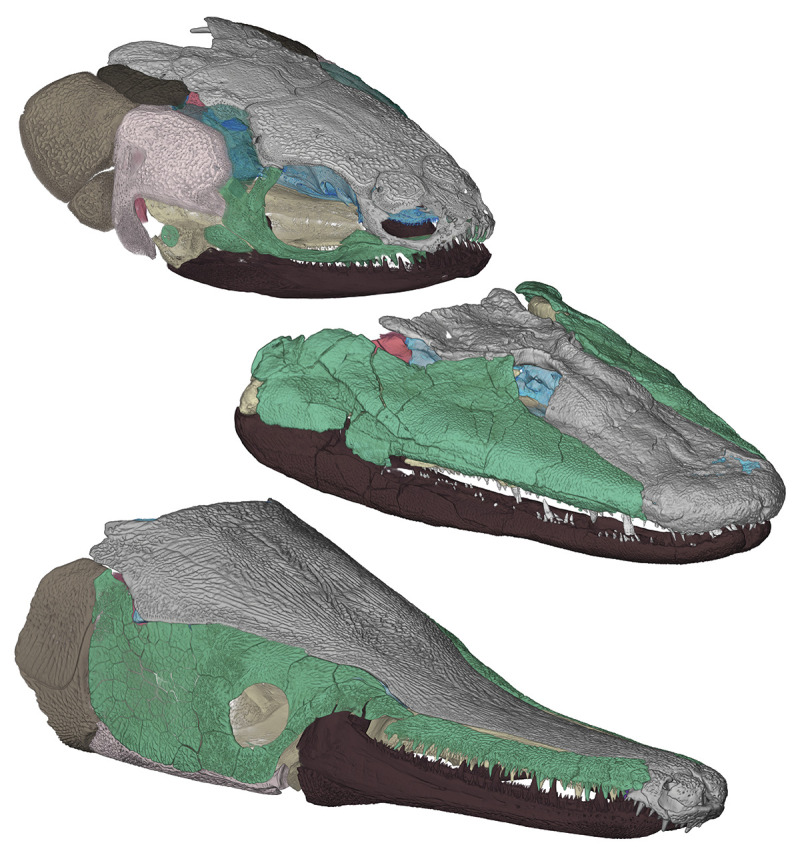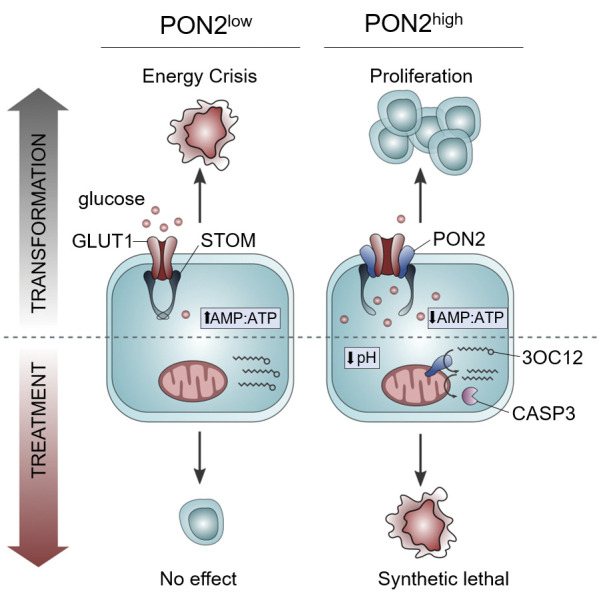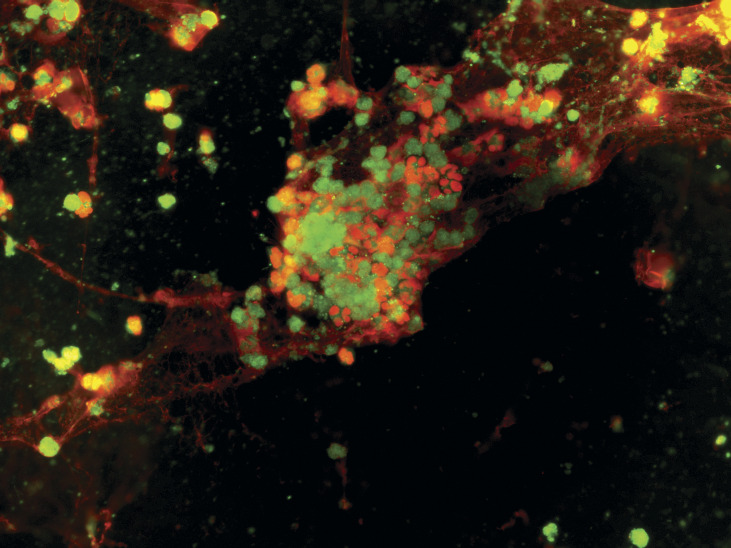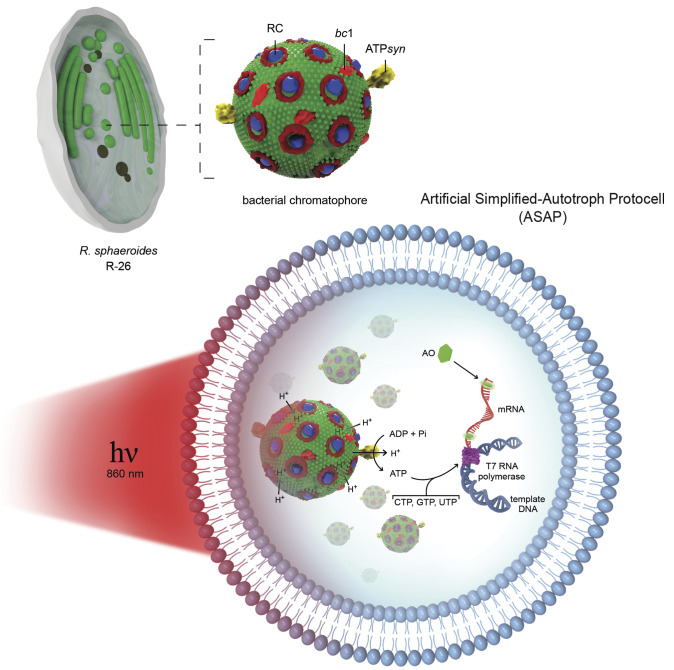MICROBIOLOGY
Reversible state in persistent Staphylococcus aureus infections
Murine abscess pus containing both live (Syto-9 in green) and dead (propidium iodide in red) S. aureus after antibiotic therapy.
Staphylococcus aureus can cause life-threatening infections such as bacteremia and endocarditis. Even nonresistant S. aureus can withstand high concentrations of antibiotics, and a bacterial subpopulation called “persisters” can cause persistent infections. Markus Huemer, Srikanth Mairpady Shambat, et al. examined S. aureus obtained directly from a patient suffering from a difficult-to-treat infection and found that host-mediated stress and antibiotic exposure promoted the formation of a persister phenotype with significant molecular changes. Combining in vivo and in vitro experiments with multiomics analysis and enrichment of persisters, the authors found that low pH conditions produce an S. aureus phenotype that is metabolically active and virulent but includes a subpopulation of low-virulence, low-energy persisters that accumulate insoluble proteins and enter dormancy. However, this dormancy is reversible as regrown persisters regain the virulence and metabolic activity of the dominant phenotype. According to the authors, the study also identifies a therapeutic approach to treat persistent S. aureus infections that combines retinoids with antibiotics and reduces persister populations in mice. — T.J.
PNAS e2014920118 (2021)
EVOLUTION
Evolution of terrestrial vertebrate feeding systems

T. roseae (Middle) and two modern analogs have expandable skulls [ornate bichir (Top), alligator gar (Bottom)].
During the transition from water to land, vertebrates shifted from a suction-based mode of prey capture to a biting-based feeding strategy. To shed light on this major step in vertebrate evolution, Justin Lemberg et al. used high-resolution microcomputed tomography to analyze the anatomy of four specimens of Tiktaalik roseae—an extinct lobe-finned fish and a key intermediate in the evolution of four-limbed animals. The authors compared the anatomy of T. roseae to that of modern and extinct vertebrates with analogous features. Similar to many groups of fishes, the skull of T. roseae is extensively jointed to enable separate movements between cranial elements and therefore may have been capable of large expansion to draw in food through suction. On the other hand, the braincase, skull roof, and the midline roof of the mouth are all integrated together into a rigid inflexible unit, which may have facilitated prey capture through biting. The anatomy of the tooth row is also suggestive of snapping. Taken together, the findings suggest that T. roseae may have used a synergistic, gar-like feeding strategy that combined snapping and suction, without necessarily trading off one for the other. According to the authors, the skull anatomy of T. roseae reveals an important transitional stage from a fish-like to a tetrapod-like feeding system, which facilitated prey capture by the earliest terrestrial vertebrates. — J.W.
PNAS e2016421118 (2021)
ENGINEERING
Adhesive nanoparticles inhibit skin tumor growth in mice
Skin cancer is the most common cancer in the United States, and squamous cell carcinoma (SCC) is the second most common subtype of skin cancer. Surgical excision of SCC tumors is not always feasible, and topical anticancer agents can produce systemic toxicity and fail to sufficiently penetrate deep-seated tumors. Jamie Hu et al. tested an alternative, localized SCC treatment approach using bioadhesive nanoparticles (BNPs)—polymers with surface molecules that are chemically modified to facilitate entry into tumor cells. The authors filled the BNPs with the potent chemotherapy drug camptothecin (CPT). Three days after injection, BNP-CPTs achieved higher retention in deep tumors in a mouse model of SCC, compared with CPT-filled nonadhesive nanoparticles (NNP-CPTs). Ten days after injection, 45% of the CPT delivered via BNPs was retained in mouse tumors, whereas CPT delivered via NNPs was undetectable. Twenty days after injection, tumor weight was lower in mice treated with BNP-CPTs compared with mice treated with NNP-CPTs. When combined with an immunostimulatory agent, BNP-CPTs delayed tumor growth better than free CPT or empty BNPs and eliminated up to 20% of tumors. According to the authors, BNP-CPT may represent a practical, safe, and effective nonsurgical option for treating SCC. — J.W.
PNAS e2020575118 (2021)
PSYCHOLOGICAL AND COGNITIVE SCIENCES
Social media language and breakups
The intertwining of social lives and social media presents opportunities to study the cognitive processes of emotional upheaval. Posts by users of the social platform Reddit persist indefinitely and are viewable by anyone. Sarah Seraj et al. report that analysis of more than one million Reddit posts reveals that subtle shifts in pronouns and other seemingly insignificant words were observable 3 months prior to an impending romantic breakup. The authors analyzed the language in 1,027,541 posts and comments from 6,803 users who reported a breakup. Analysis included the user’s writing from across the platform 1 year prior to and 1 year after their first post to the r/BreakUps group, a proxy for the date of the breakup. Statistically significant language-use changes from baseline were present 1 month prior to breakup disclosure and lasted up to 3.5 months post breakup. More personal, less structured language indicated drops in analytic thinking. Use of cognitive processing words spiked at the time of breakup. The authors noted similar trends in two other forums discussing emotional upheavals, but not in r/cooking, which was used as a control. According to the authors, the results suggest a natural evolution in the language that people use before, during, and after a breakup. — T.H.D.
PNAS e2017154118 (2021)
CELL BIOLOGY
High PON2 levels jumpstart leukemogenesis in developing B cells

PON2 enables glucose uptake and energy production by blocking the interaction between GLUT1 and its inhibitor STOM. This mitigates energy crisis caused by the metabolic gatekeepers and promotes leukemogenesis in B-ALL.
In the adaptive immune system, developing B cells cut and rearrange their DNA sequences multiple times via processes known as somatic recombination and hypermutation. Although these rearrangements fine-tune B cells to recognize specific pathogens, the accumulation of DNA double-strand breaks substantially increases the risk of malignant transformation. Lili Pan, Chao Hong, Lai Chan, et al. examined B cell acute lymphoblastic leukemia (B-ALL) and report that aberrant expression of the lactonase PON2 in B-ALL cells may jumpstart leukemogenesis. In normal pre-B cells, B-lymphoid transcription factors, for example PAX5 and IKZF1, and low PON2 levels restrict glucose uptake and energy supply to levels that are insufficient for leukemogenesis. Analyzing data from clinical trials, the study reveals that PON2 expression in adult and pediatric patients is elevated in B-ALL cells and that high PON2 levels correlate to poor clinical outcomes. Using mouse models, the authors offer a mechanistic explanation whereby PON2 releases the glucose-transporter GLUT1 from its inhibitor stomatin. The study also demonstrates that deleting the Pon2 gene protects transplant recipient mice from developing fatal leukemia disease in vivo. The study points to PON2 as exerting metabolic control over glucose uptake and subsequent ATP production in B-ALL, according to the authors. — T.J.
PNAS e2016553118 (2021)
BIOPHYSICS AND COMPUTATIONAL BIOLOGY
Artificial protocell uses bacterial chromatophores to photosynthesize ATP
Artificial simplified-autotroph protocells exploit bacterial chromatophores as photosynthetic organelle-like modules to sustain RNA biosynthesis. Image credit: Filippo Trazzi (Politecnico di Torino, Turin, Italy).
Living cells power most cellular processes by releasing energy stored in an organic molecule called adenosine 5’-triphosphate (ATP). In the field of bottom-up synthetic biology, researchers break down processes like autonomous energy production into their core components, to recreate the complexity of living cells in artificial compartments engineered for use in artificial simplified-autotroph protocells, or ASAPs. Emiliano Altamura, Paola Albanese, et al. describe a hybrid, multicompartment protocell that uses bacterial chromatophores to efficiently photophosphorylate adenosine 5’-diphosphate to ATP. Each protocell houses some 26,000 chromatophores acting as natural, nanosized photosynthetic organelles that, under continuous illumination, can produce up to 100 molecules of ATP per second per molecule of ATP synthase. In addition, the authors present proof-of-concept analyses with confocal microscopy that show that the ATP produced is both viable and sufficient to power DNA transcription within the protocell. By incorporating biological and artificial components that are both easy to obtain and ready for use, the author’s hybrid design offers practical advantages over a bottom-up approach that can potentially advance biomedical innovation and research into the origins of life on Earth, according to the authors. — T.J.
PNAS e2012170118 (2021)
PSYCHOLOGICAL AND COGNITIVE SCIENCES
Infants may learn about native speech sounds without phonetic categories
Adults struggle to discern consonant and vowel sounds in foreign languages. For example, the American English words “rock” and “lock” often sound the same to native Japanese speakers. One predominant theory argues that during the first year of life infants learn to involuntarily map incoming sounds into native phonetic categories—a filter for one’s own native vowel and consonant sounds—through a statistical clustering approach known as distributional learning. Thomas Schatz et al. present a quantitative modeling framework that uses realistic input to simulate the language learning process, providing a way to test predictions about infants’ early phonetic knowledge. By shifting focus from what infants learn to how they might learn, the authors show that a distributional learning algorithm can predict observed early phonetic learning in Japanese and American English infants, lending support to the core principle behind distributional learning. However, the model also reveals that speech units learned via this mechanism are too brief and acoustically inconsistent to correspond to phonetic categories. This latter finding challenges the established wisdom regarding the time course of early language acquisition, according to the authors. — T.J.
PNAS e2001844118 (2021)
SYSTEMS BIOLOGY
Hormone seasonality in humans
Hormones control several biological functions in mammals, including growth, metabolism, reproduction, and responses to stress. However, it is unclear whether human hormones exhibit seasonal patterns, given that detecting such patterns requires hormone measurements. Avichai Tendler et al. analyzed the results of hormone blood tests collected between 2002 and 2017 from almost 3.5 million adults aged 20–80 years and living in Israel. Data came from the medical database of the Israeli health-service Clalit. The test results demonstrated that human hormones exhibit patterns of seasonality. Effector hormones peaked between winter and spring. However, most upstream regulating pituitary hormones for growth, reproduction, and stress peaked in late summer. The delay of pituitary hormones was unexpected, given that hormone circuit delays typically last hours rather than months. By modeling the adrenal and pituitary glands, the authors also determined that gland masses grow within months due to hormones’ trophic effects, producing a feedback circuit with a natural annual frequency. The findings suggest that hormone seasonality in humans may have a physiological peak season for biological functions, according to the authors. — M.S.
PNAS e2003926118 (2021)
EVOLUTION
Evolutionary history of turtles
As one of the major vertebrate lineages, turtles are ancient, have few extant species, and are highly endangered. Robert Thomson et al. investigated the evolutionary history of turtles to identify factors that shaped their diversity through time. The authors collected DNA samples from 591 individual turtles representing 80% of all extant species, estimated their phylogeny, and measured rates of diversification. Species diversification in turtles was associated with historical climate shifts, with most species arising within the last 50 million years; this time frame coincides with declines in global sea level that reshaped and exposed new continental margins. As new coastal habitats emerged and were independently colonized by several turtle lineages, turtles experienced a threefold increase in their speciation rate, generating most of the current turtle diversity. The findings suggest that habitats exposed along continental margins were once critical in supporting turtle speciation and remain key to the current persistence of turtles. Furthermore, the loss and degradation of such habitats due to accelerated climate change may also threaten the persistence of other species across the globe, according to the authors. — M.S.
PNAS e2012215118 (2021)
ANTHROPOLOGY
How an animal’s teeth can reveal where it’s been
Nomadic herders in western Mongolia roam throughout the year to to feed their sheep and goats. Researchers found a way to track those movements by analyzing strontium isotopes in the animals’ tooth enamel. Image credit: Antoine Zazzo.
Posted on February 5, 2021
Stephen Ornes
A careful measurement of isotope ratios in animals’ teeth could offer a new way to closely track their movements, according to a recent study that showed how the approach would work in Mongolian sheep and goat herds. Continue Reading⇒





